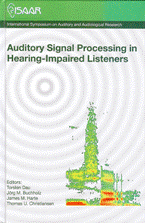Time constants of compression schemes – Less is more?
Abstract
In recent years, Wide Dynamic Range Compression (WDRC) has been established in the listening device industry so that it became the most utilized tool in modern hearing instruments. However, although the general system has become status quo, the question of a correct tting of the necessary parameters is still open. The developed tting rules only calculate the target gain and perhaps the compression ratio, the number of channels and/or the compression kneepoints. Unfortunately, the time constants are generally not considered. The present work presents investigations into this area. Two compression systems operating with completely different time constants were compared. One system works instantaneously with very short time constants. Additionally, the applied gain and compression depends on the distance of the instantaneous frequency from the centre frequency of the particular frequency band. The sec- ond system is a compression system which is already available in commercial hearing devices and which allows limited access to the time constants. For the evaluation, both subjective and objective speech tests were used. In addition, a static and a dynamic loudness scaling method were integrated to provide information regarding how the loudness is normalized. In the third part of the evaluation, several sound samples were presented in different level ranges to be judged (i) absolutely using questionnaires and (ii) relatively in complete paired comparisons. In all cases, the compression systems were evaluated in level ranges relevant for real life listening situations. The results found with the instantaneous compression system do not con rm the assumption of improved speech intelligibility in modulated noise but they show a better restoration of loudness than in conventional compression systems without deteriorating the sound quality.
References
Brand, T., and Hohmann, V. (2002). “An adaptive procedure for categorical loudness scaling,” J. Acoust. Soc. Am. 112, 1597-1604.
Giguère, C., and Smoorenburg, G. F. (1999). “Computational modeling of outer hair- cell damage: implications for hearing and signal processing,” Psychophysics, Physiology, and Methods of Hearing, T. Dau, V. Hohmann, and B. Kollmeier, Eds.: 155-164.
Grimm, G., Herzke, T, Berg, D., and Hohmann, V. (2006). “The Master Hearing Aid: A PC-Based Platform for Algorithm Development and Evaluation,” Acta Acus- tica 92, 618-628.
Hansen, M. (2002). “Effects of multi-channel compression time constants on subjectively perceived sound quality and speech intelligibility,” Ear and Hearing 23, 369-380.
Herzke, T., and Hohmann, V. (2005). “Effects of instantaneous multiband dynamic compression on speech intelligibility,” EURASIP JASP 2005(18), 3034-3043.
Hohmann, V., and Kollmeier, B. (2007). “A nonlinear auditory filterbank controlled by sub-band instantaneous frequency estimates. International Symposium on Hearing – ISH 2006, Cloppenburg, Germany, Springer.
Hohmann,V. (2007). “Compensation of hearing deficiencies in the inner ear,” proceedings of EFAS/DGA joint congress, Heidelberg, DGA - Deutsche Gesellschaft für Audiologie.
Kiessling, J., Müller, M., and Latzel, M. (2006). “Fitting strategies and candidature criteria for unilateral and bilateral hearing aid fittings,” Intern. J. of Audiol. 45, 53-62.
Souza, P.E. (2002). “Effects of compression on speech acoustics, intelligibility, and sound quality,” Trends Amplif .6, 131-165.
Verschuure, J., Maas, A. J. J, Stikvoort, R.M., de Jong, R.M., Goedegebure, A., and Dreschler, W.A . (1995). “Compression and its effect on the speech signal,” Contribution at Third International Hearing Aid Conference Iowa.
Wagener, K., Kühnel, V., and Kollmeier, B. (1999). “Entwicklung und Evaluation eines Satztests für die deutsche Sprache I: Design des Oldenburger Satztests,” Zeitschrift für Audiologie/ Audiological Acoustics, 38, 4-15.
Wagener, K.C., and Brand, T. (2005). “Sentence intelligibility in noise for listeners with normal hearing and hearing impairment: Influence of measurement procedure and masking parameters,” Intern. J. Audiol 44, 144-157.
Wagener, K.C., Brand, T., and Kollmeier, B. (2006). “The role of silent intervals for sentence intelligibility in fluctuating noise in hearing-impaired listeners,” Intern. J. Audiol. 45, 26-33.
v. Wallenberg, E.L., and Kollmeier, B. (1989). “Sprachverständlichkeitsmessungen für die Audiologie mit einem Reimtest in deutscher Sprache: Erstellung und Evaluation von Testlisten,” Audiologische Akustik, 38., 50-65
Additional Files
Published
How to Cite
Issue
Section
License
Authors who publish with this journal agree to the following terms:
a. Authors retain copyright* and grant the journal right of first publication with the work simultaneously licensed under a Creative Commons Attribution License that allows others to share the work with an acknowledgement of the work's authorship and initial publication in this journal.
b. Authors are able to enter into separate, additional contractual arrangements for the non-exclusive distribution of the journal's published version of the work (e.g., post it to an institutional repository or publish it in a book), with an acknowledgement of its initial publication in this journal.
c. Authors are permitted and encouraged to post their work online (e.g., in institutional repositories or on their website) prior to and during the submission process, as it can lead to productive exchanges, as well as earlier and greater citation of published work (See The Effect of Open Access).
*From the 2017 issue onward. The Danavox Jubilee Foundation owns the copyright of all articles published in the 1969-2015 issues. However, authors are still allowed to share the work with an acknowledgement of the work's authorship and initial publication in this journal.


